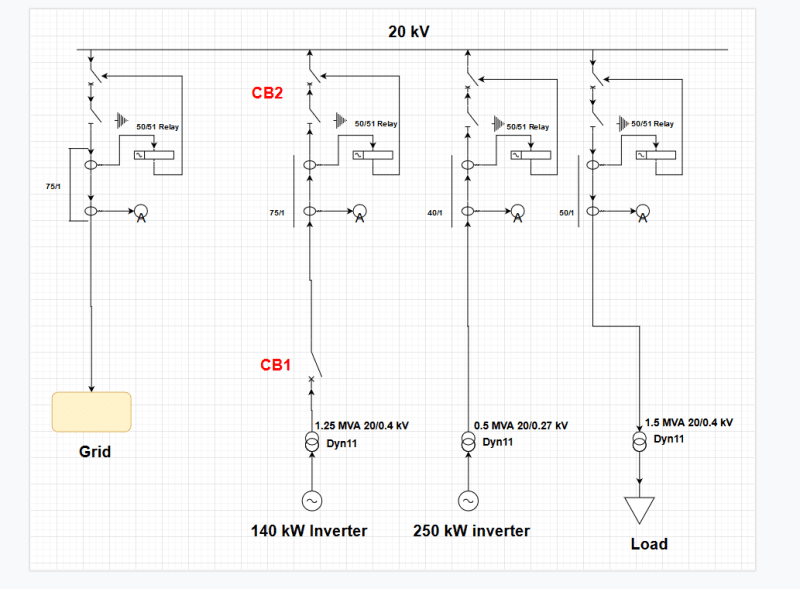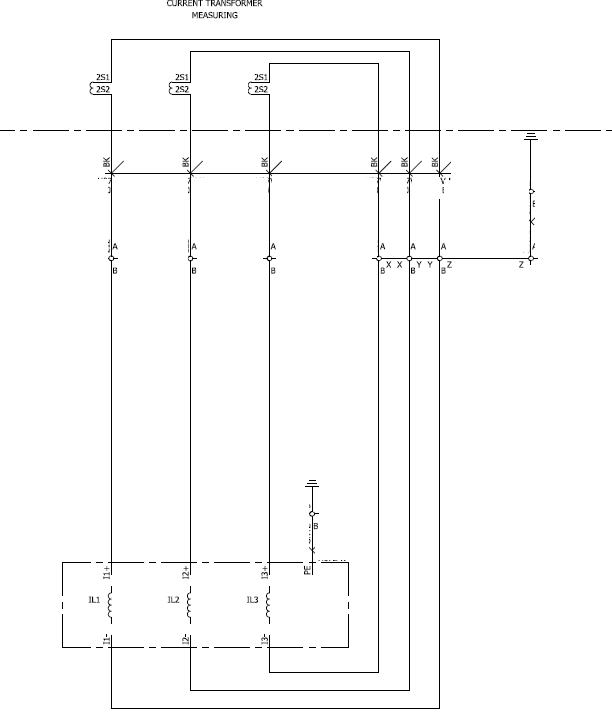Eduardo Diaz
Electrical
Dear all,
I am new to the forum and I would like to say thanks in advance for wahtever insight you may give me about a recent issue I have found.
We have a 20 kV switchgear center and in one of the switchgears, which allow the injection of energy generated by an inverter, there are two 75/1 A current transformer (measurement and protection) (75 A nominal current at the primary), which are clearly oversized as the maximum apparent power flowing through that switchgear at 20 kV will be 200 kVA at most. The cables at the secondary of the CT are simply H07V-K non shielded, and all the switchgears are next to the other.
After the 75/1 CTs (there are one for measurement and another one for protection) there is a circuit breaker with a disconnector. Before the 75/1 CT there are only a 1.5 MVA 20/0.4 kV power transformer (also oversized), followed by a circuit breaker and a measurement equipment. So, summarisizing, after the inverter there is a 1.5 MVA power transformer, measurement equipment, circuit breaker (CB1), 10 m 20 kV cable, 75/1 A CTs, disconnector and circuit breaker (CB2), and the rest of the plant, in this order.
We have found 2 big issues that I would like to share with you in case you may give me a hint of what's going on.
1) When we disconnect the CB1 of the switchgear and the CB2(so there shouldn't be no power flow and current through the CT whatsoever), I am pretty sure of this), the CT still measures current. At 20 kV it is measuring 0.15 A approximately. The other switchgears are injecting current so there could be induced currents, but the 20 kV cables are shielded. If I have explained myself correctly, it should be understood that the circuit between the power transformer and the CB1 is completely isolated, and still measures current!
2) When closing both circuit breakers, with the PCS just consuming active power for their auxiliary services, the measurement equipment registers a 20 kVAr injection from the power transformer to the rest of the installation.
Looking forward for your replys.
Thank you very much!
Kind regards,
Eduardo
I am new to the forum and I would like to say thanks in advance for wahtever insight you may give me about a recent issue I have found.
We have a 20 kV switchgear center and in one of the switchgears, which allow the injection of energy generated by an inverter, there are two 75/1 A current transformer (measurement and protection) (75 A nominal current at the primary), which are clearly oversized as the maximum apparent power flowing through that switchgear at 20 kV will be 200 kVA at most. The cables at the secondary of the CT are simply H07V-K non shielded, and all the switchgears are next to the other.
After the 75/1 CTs (there are one for measurement and another one for protection) there is a circuit breaker with a disconnector. Before the 75/1 CT there are only a 1.5 MVA 20/0.4 kV power transformer (also oversized), followed by a circuit breaker and a measurement equipment. So, summarisizing, after the inverter there is a 1.5 MVA power transformer, measurement equipment, circuit breaker (CB1), 10 m 20 kV cable, 75/1 A CTs, disconnector and circuit breaker (CB2), and the rest of the plant, in this order.
We have found 2 big issues that I would like to share with you in case you may give me a hint of what's going on.
1) When we disconnect the CB1 of the switchgear and the CB2(so there shouldn't be no power flow and current through the CT whatsoever), I am pretty sure of this), the CT still measures current. At 20 kV it is measuring 0.15 A approximately. The other switchgears are injecting current so there could be induced currents, but the 20 kV cables are shielded. If I have explained myself correctly, it should be understood that the circuit between the power transformer and the CB1 is completely isolated, and still measures current!
2) When closing both circuit breakers, with the PCS just consuming active power for their auxiliary services, the measurement equipment registers a 20 kVAr injection from the power transformer to the rest of the installation.
Looking forward for your replys.
Thank you very much!
Kind regards,
Eduardo


